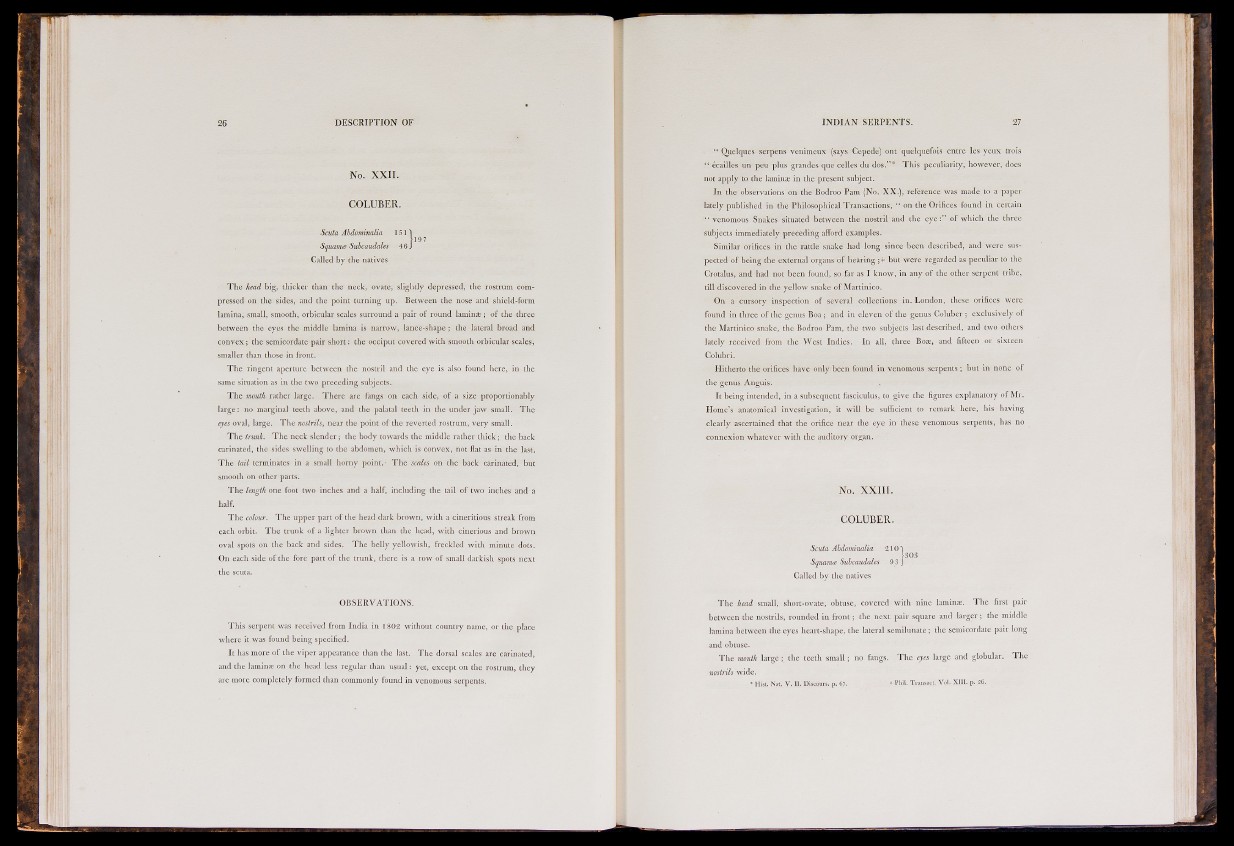
26 DESCRIPTION OF
No. XXII.
COLUBER.
Smta Abdominalia 151]
[ l 9 7
Squama Suhcmidales 4 6 J
Called by the natives
The head big, thicker than the neck, ovate, slightly depressed, the rostrum compressed
on the sides, and the point turning up. Between the nose and shield-form
lamina, small, smooth, orbicular scales sun-ound a pair of round lamin® ; of the three
between the eyes the middle lamina is narrow, lance-shape ; the lateral broad and
convex ; the semicordate pair short: the occiput covered with smooth orbicular scales,
smaller than those in front.
The ringent aperture between the nostril and the eye is also found here, in the
same situation as in the two preceding subjects.
The viouth rather large. There are fangs on each side, of a size proportionably
large: no marginal teeth above, and the palatal teeth in the under jaw small. The
eyes oval, large. The nostrils, near the point of the reverted rostrum, very small.
The Irtmk. The neck slender ; the body towards the middle rather thick ; the back
carinated, the sides swelling to the abdomen, which is convex, not flat as in the last.
The tail terminates in a small horny point. The scales on the back carinated, but
smooth on other parts.
The Imgtk one foot two inches and a half, including the tail of two inches and a
half.
The colour. The upper part of the head dark brown, with a cineritious streak from
each orbit. The trunk of a lighter brown than the head, with cinerious and brown
oval spots on the back and sides. The belly yellowish, freckled with minute dots.
On each side of the fore part of the trunk, there is a row of small darkish spots next
the scuta.
OBSERVATIONS.
This serpent was received from India in I 802 without country name, or tiie place
where it was found being specified.
It has more of the viper appearance than the last. The dorsal scales are carinated,
and the lamins on the head less regular than usual: yet, except on the rostrum, they
are more completely formed than commonly found in venomous serpents.
I N D I AN SERPENTS. 27
" Quelques serpens venimeux (says Cepede) ont quelquefois entre les yeux trois
" écailles un peu plus grandes que celles du dos."* This peculiarity, however, does
not apply to the laminae in the present subject.
In the observations on the Bodroo Pam (No. XX.), reference was made to a paper
lately published in the Philosophical Transactions, " on the Orifices found in certain
" venomous Snakes situated between the nostril and the eye:" of which the three
subjects immediately preceding afford examples.
Similar orifices in the rattle snake had long since been described, and were suspected
of being the external organs of hearing ; t but were regarded as peculiar to the
Crotalus, and had not been found, so far as I know, in any of the other serpent tribe,
till discovered in the yellow snake of Martinico.
On a cursory inspection of several collections in, London, these orifices were
found in three of the genus Boa ; and in eleven of the genus Coluber ; exclusively of
the Martinico snake, the Bodroo Pam, the two subjects last described, and two others
lately received from the West Indies. In all, three Boae, and fifteen or sixteen
Colubri.
Hitherto the orifices have only been found in venomous serpents ; but in none of
the genus Anguis.
It being intended, in a subsequent fasciculus, to give the figures explanatory of Mr.
Home's anatomical investigation, it will be sufficient to remark here, his having
clearly ascertained that the orifice near the eye in these venomous serpents, has no
connexion whatever with the auditory organ.
No. XXIII.
COLUBER.
Scuta Abdominalia 210"1
|303
Sqiiama; Subcatidales 9 3 J
Called by the natives
The head small, short-ovate, obtuse, covered with nine lamina. The first pair
bet-ween the nostrils, rounded in front; the next pair square and larger ; the middle
lamina between the eyes heart-shape, the lateral semihuiate; the semicordate pair long
and obtuse.
The mouth large ; the teeth small; no fangs. The eyes large and globular. The
nostrils wide.
• Hist. Nat. V. n. Discoui's. p. 67. + I'liil- Transacl. Vol. XIII. p. 26.